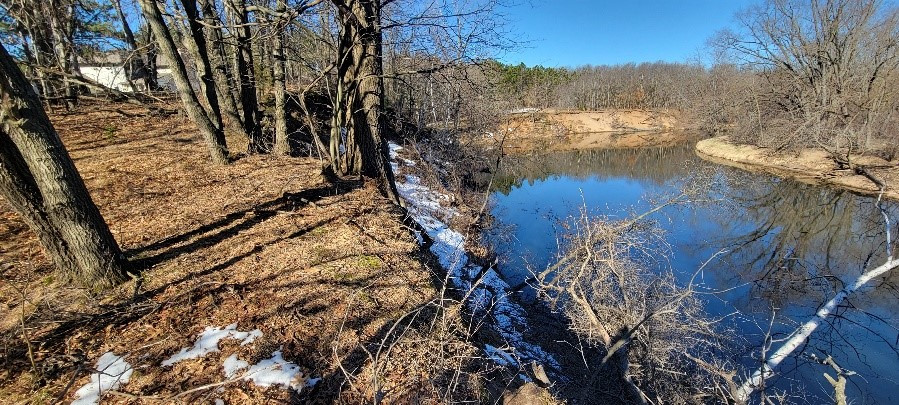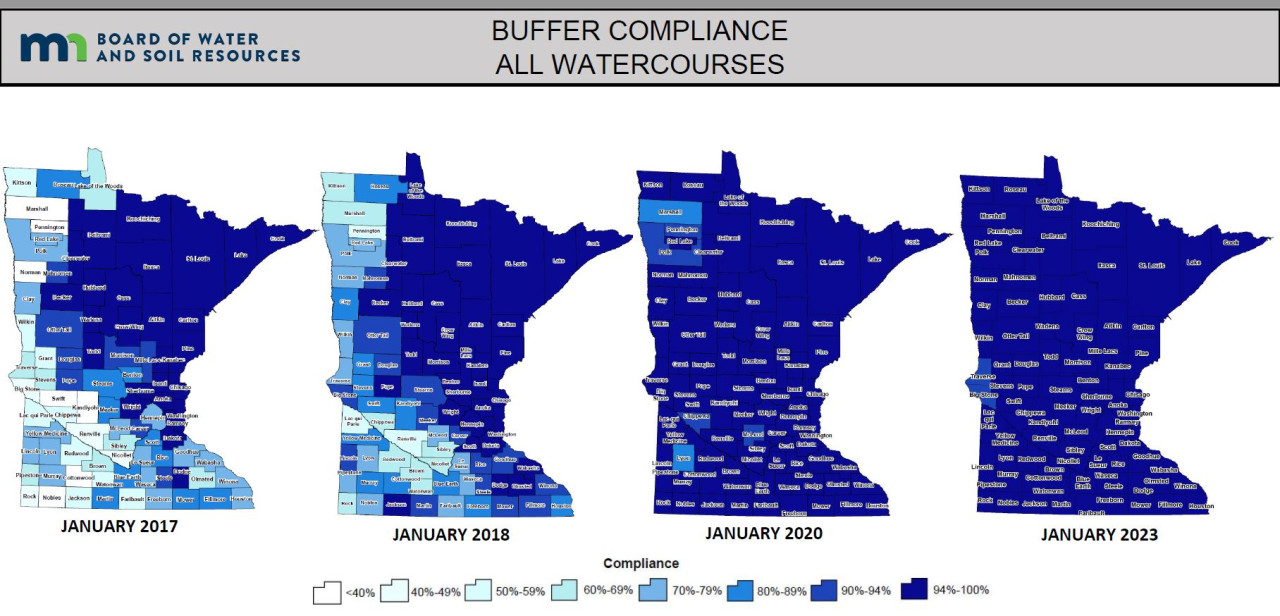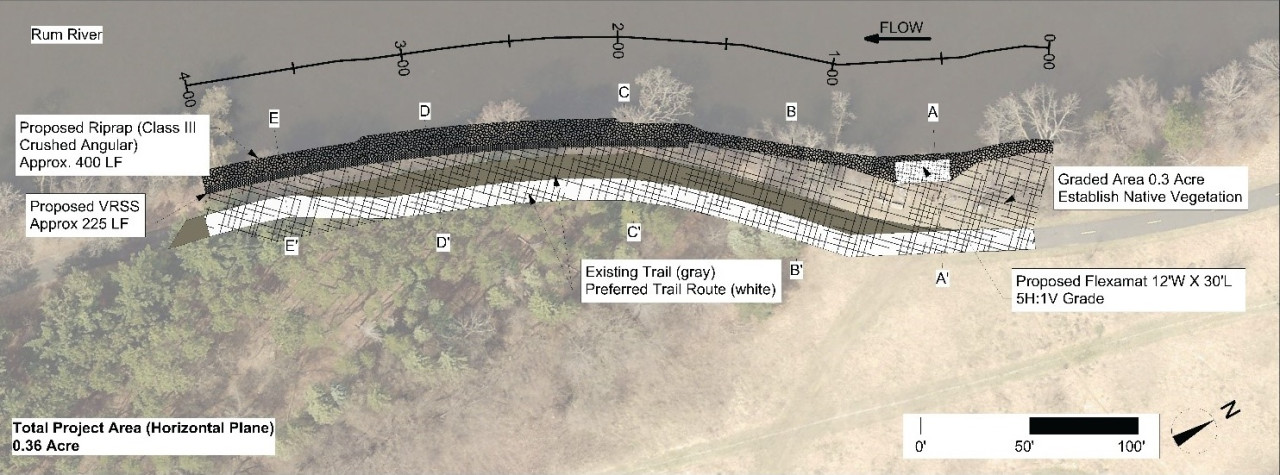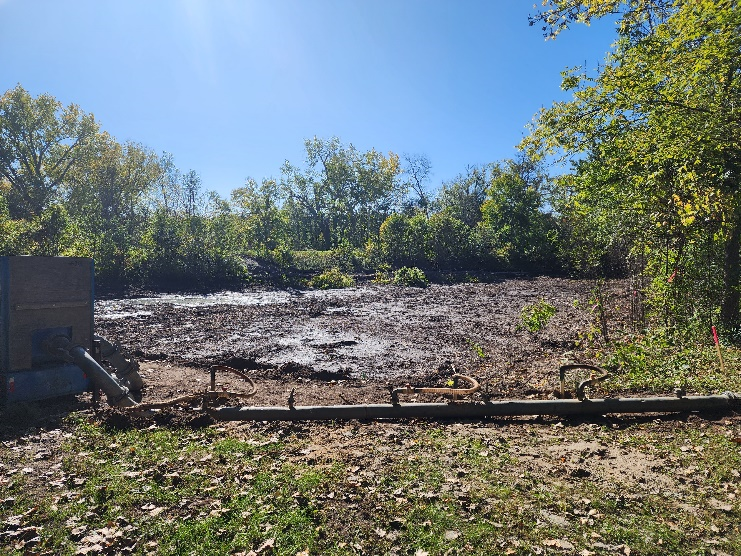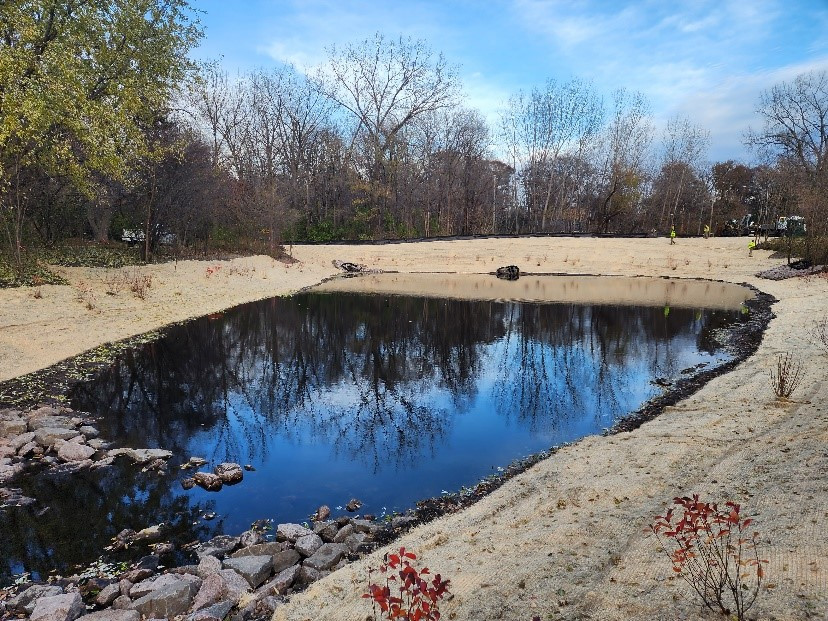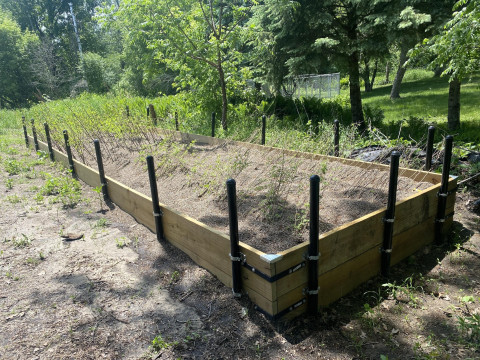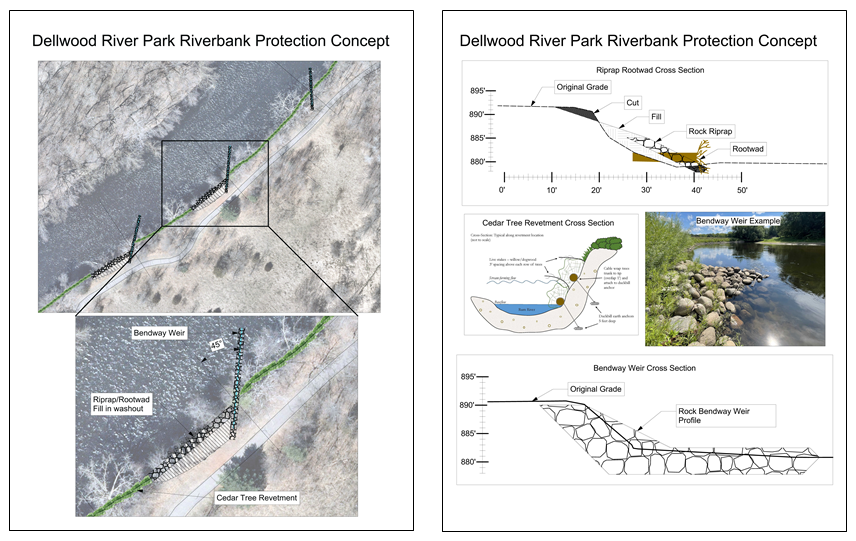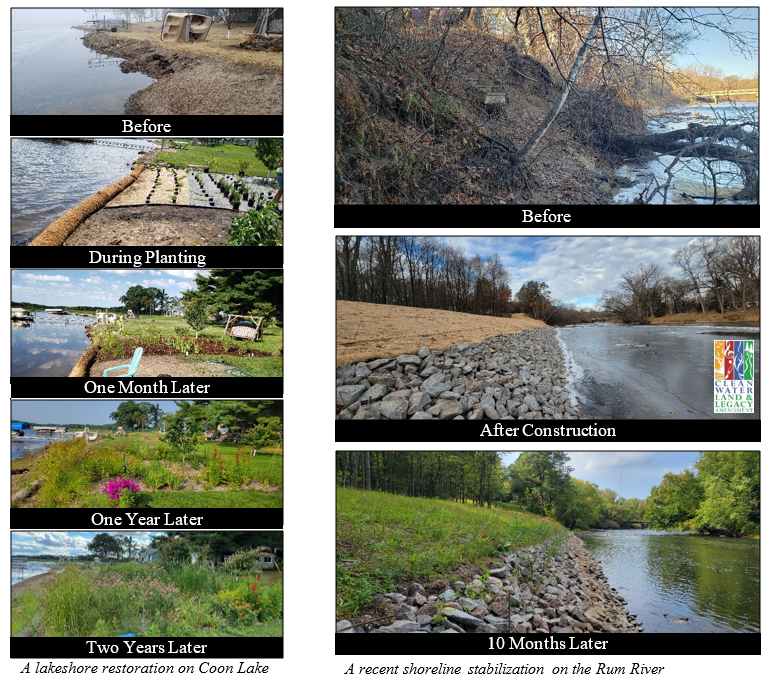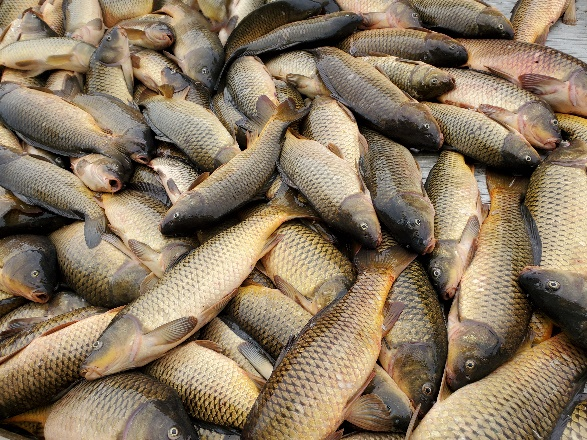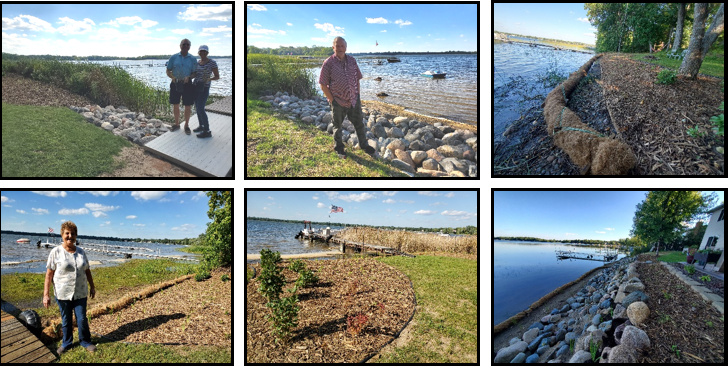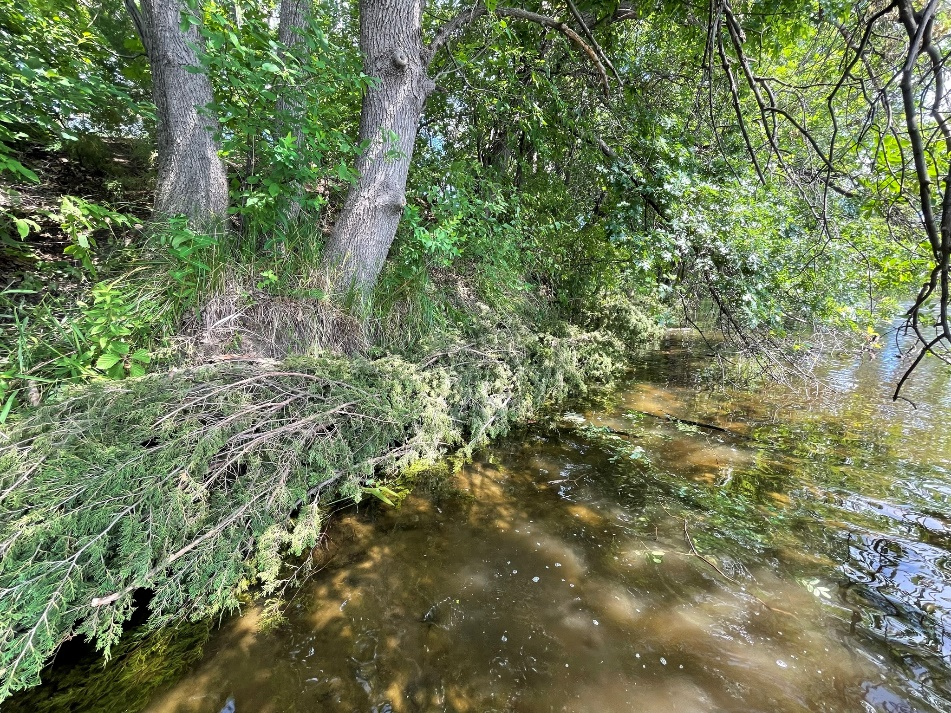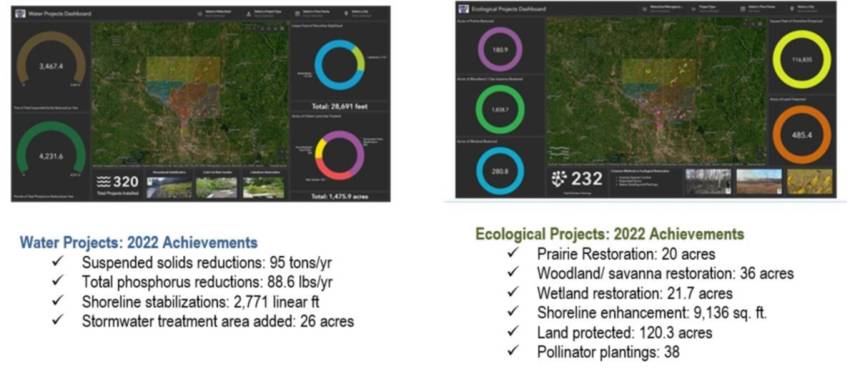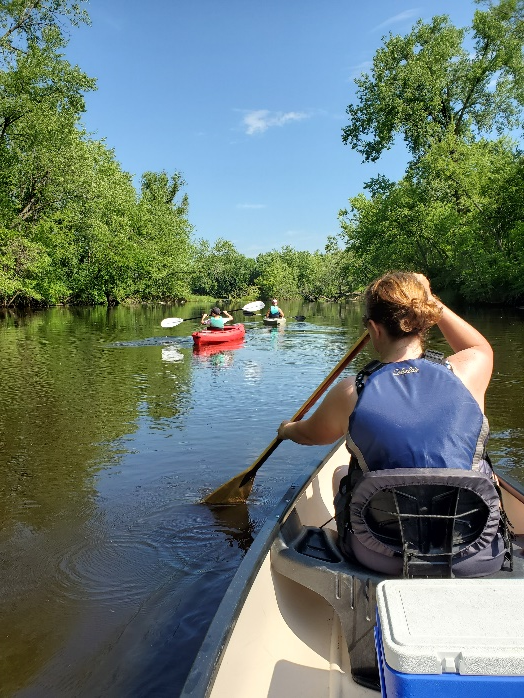Ford Brook is a stream tributary to the Rum River draining over 24,000 acres of rural lands in northwestern Anoka County. Nutrient concentrations in Ford Brook regularly exceed state standards for impairment, thereby contributing to excess nutrient loading in the Rum River. Addressing this issue requires watershed-level analyses and an understanding of which best management practice (BMP) would provide the greatest benefit per dollar spent; ACD's Subwatershed Analysis ("SWA") approach does just this.
ACD has completed over 20 urban SWAs in order to strategically plan for BMPs such as stormwater ponds, rain gardens, and subsurface structures treating stormwater runoff. However, replicating this process in rural watersheds, dominated by agriculture, required different tools and techniques; ACD achieved this for the Ford Brook Watershed through the use of desktop analyses, targeted water quality monitoring, field surveys, and a new modeling tool called PTMApp.
As a result, over 250 candidate water quality improvement projects were sited within the Ford Brook Watershed. The majority of these are agricultural practices such as cover crops, no-till farming, grassed waterways, water and sediment control basins, and enhanced riparian buffers, but additional practices such as prescribed grazing, wetland restorations, and lakeshore stabilizations were also included. For each practice, anticipated costs and water quality benefits to Ford Brook were generated, and all findings are summarized in detail in the corresponding SWA report. This report will be a valuable asset as we pursue nutrient reduction goals in Ford Brook and, by extension, the Rum River. For more information contact Breanna Keith, Water Resource Specialist at
Plans, permits, and bids have come together to stabilize one of the highest priority eroding riverbanks along the Rum River in Anoka County. The project spans multiple properties and will stabilize some of the tallest and most severely eroding riverbanks on the Rum River in Anoka County.
A portion of this stretch was ranked in the top two of over eighty identified eroding banks during a 2017 erosion inventory. Through the stabilization of this stretch of bank, annual pollutant loading to the Rum River is estimated to be reduced by 473-tons of sediment, and 402-lbs of total phosphorus. Construction is planned to begin around September 1st, 2024, and should wrap up prior to winter. Photo: Surveying the tall eroding bank.
Funding sources include grant dollars from the Clean Water Fund and Outdoor Heritage Fund (both from the Clean Water, Land, and Legacy Amendment) as well as match dollars from the landowners, Anoka County, and the Upper Rum River WMO. For more information contact Jared Wagner, Water Resource Specialist, at
Nearly a decade after Minnesota's buffer law was enacted in 2015, 99.8% of parcels adjacent to Minnesota waters are in compliance with the law. Buffers are also known as a riparian filter strip adjacent to a stream, river, lake, or wetland. These buffers filter out phosphorus, nitrogen, and sediment. Studies completed by the Minnesota Pollution Control Agency show that buffers are important for protecting and restoring water quality, natural stream functions, and aquatic habitat and life. Buffers are required along public waterways and ditches. Public waterways include lakes, rivers, and streams. This type of waterway requires a 50-foot average buffer. Buffers of 16.5 feet are required along public ditches.
ACD was proud to announce that Anoka County was 100% compliance back in fall, 2020. This milestone was achieved through strong partnerships between Anoka County, ACD, local landowners, and BWSR. This achievement doesn't mean that the hard work is over but it does represent a great success and displays the impact that strong environmental policy can have across the state of Minnesota. The next phase, includes another ACD review of properties throughout Anoka County to identify non-compliant parcels. This review began in Spring, 2024 and is based on recently released aerial photos. Compliance status and progress is tracked using the Buffer Compliance and Tracking Tool (BuffCAT), a state developed GIS database and mapping system.
Transfers in property ownership and land management changes, will require ongoing efforts by ACD in order to maintain existing compliance and to bring other parcels into compliance. Many landowners with noncompliant parcels have plans in place to seed the sites, or to implement an alternative conservation practice that provides comparable water-quality benefits this spring. Visit the ACD website to learn more about Buffer law implementation or contact Kris Larson, Water Resource Specialist, at
Erosion along 400-feet of Rum riverbank at a City of Anoka riverfront easement is causing sediment loading and tree loss, and has washed out a highly used walking trail. The design features three primary protection measures detailed below.
1. The toe of the bank, mostly below the water line, will be armored with a rock. The rock will be installed up to the two-year flood elevation (50% of years it will be completely covered). This lowers the top of the rock by two feet compared to the standard approach. This allows habitat friendly approaches above.
2. Above the rock, the bank will be seeded with a native plants, and staked with willow and dogwood. Native vegetation provides habitat benefit and root structure to anchor the soil in place. We may grade the bank back to a flatter, more stable slope. Alternatively, we may use a series of wrapped soil lifts called a "vegetated reinforced soil system" to maintain a steeper slope that is still stable and vegetated. The final decision will be based on bids received.
3. There is a heavily used informal access point at the upstream end of this site. This area gets beat down by heavy foot traffic. We will use one roll of articulated concrete block to offer stable footing and reduce the erosion caused by that foot traffic.
For more information contact Jared Wagner, Water Resource Specialist, at
The proposed removal of Golden Lake from Minnesota's impaired waters list was highlighted in a recent Board of Water and Soil Resources (BWSR) article that underscores the importance of Clean Water Funds (CWF) for measurable water quality improvement. ACD secured two CWF grants for iron-enhanced sand filters (IESF) to reduce phosphorus reaching Golden Lake, located in Circle Pines, MN. Iron-filings mixed throughout the sand, capture phosphorus from stormwater passing through the filters. One IESF was installed in Centennial Green Park (2015) in the City of Blaine, and the other was installed in the City of Circle Pines (2019). Both projects were identified as cost-effective phosphorus reduction options in a Golden Lake stormwater retrofit analysis completed by ACD.
The proposed delisting of Golden Lake is a testament to the hard work and collaboration by many, including ACD, the City of Blaine, the City of Circle Pines, and the Rice Creek Watershed District. Mitch Haustein, ACD's Stormwater and Shoreland Specialist, assisted with the projects and was interviewed for the article. Click here to read the full article from BWSR that also includes brief stories about proposed delistings for 6 other Twin Cities area lakes, 1 Wright County river reach, and 1 Winona County stream segment.
For more information contact Mitch Haustein, Stormwater & Shoreline Specialist, at
Stormwater runoff from human-modified landscapes is a source of excess water and pollutants that can significantly impact rivers, lakes, and wetlands on the receiving end. However, not all drainage areas are created equally; rural landscapes with abundant agriculture and artificial drainage features, or urban areas with infrastructure predating stormwater treatment regulations, are often the most impactful. Areas draining to a priority waterbody are targeted for Subwatershed and Stormwater Retrofit Analyses (SRAs and SWAs). In these analyses, we study how runoff is moving through the landscape, strategically place various Best Management Practices (BMP's), and estimate their anticipated water quality benefits and installation costs. These findings are then summarized into a report which can be referenced by ACD staff and local natural resource managers to pursue the most cost effective projects.
ACD has completed several SRA/ SWA reports, but current efforts are focused on areas draining to the Rum and Mississippi rivers. Projects sited in these areas include rain gardens, subsurface treatment structures, enhanced street sweeping, wetland restorations, soil health practices (cover crops, no- till farming, etc.), and targeted agricultural practices (grassed waterways, riparian buffer enhancements, control basins, etc.). Altogether, approximately 150 urban BMPs and over 300 rural BMPs have been sited, and their associated SRA/ SWA reports will be released in the coming months.
For more information contact Breanna Keith, Water Resources Technician, at
The Apex Pond enhancement project in the City of Fridley is complete! Project planning began in 2022 with surveying, testing soils for on site contaminants, and design development. Construction began in fall, 2023 and spreading native seed and securing erosion control blanket over the upper slopes surrounding the pond were the final elements needed to complete installation. Originally constructed in 1999 with a ponding depth of one foot for rate control of runoff, the enhanced pond is approximately six feet deep and provides water quality treatment for nearly 90 acres of residential neighborhoods. The increased ponding depth enables sediment and nutrients to settle and accumulate in the pond basin.
For more information contact Mitch Haustein, Stormwater and Shoreland Specialist,
Six curb-cut rain gardens were installed approximately one-year ago and have been capturing runoff and its associated pollutants ever since. With each rainfall, runoff flowing in the street gutter is redirected into the rain gardens via a cut in the curb. Following a rain event, the water that enters the rain gardens is able to soak into the ground, which better mimics the natural hydrology before impervious surfaces (e.g. roofs, driveways, roads, etc.) and storm sewers directed runoff directly to Rice Creek. The rain gardens are able to store water and are filled with native species that were carefully selected for the site-specific conditions (e.g. light, soil type, and moisture).
Cumulatively, the six rain gardens are estimated to infiltrate 455,000 gallons of water, as well as remove 605 pounds of sediment and two pounds of phosphorus loading to Rice Creek annually. The native plants help to maximize infiltration and provide the co-benefit of pollinator habitat. One additional rain garden is located adjacent to a trail entrance into Locke County Park, providing an excellent public education opportunity.
These rain gardens were installed in partnership with the landowners, the City of Fridley, and the Rice Creek Watershed District. ACD provided design services and construction oversight.
The rain garden shown in the pictures below was planted last summer and as you can see, it didn't look like much at the time. Now, it looks beautiful and is full of flowers which pollinators love! This rain garden captures curbside runoff from 6.5 acres of neighborhood which previously went untreated to the Rum River. The native plant's roots create channels through the soil and reduce compaction, ensuring a maximum amount of water can infiltrate into the ground. The homeowners who worked with ACD to make this rain garden a reality, kept weeds at bay, and provided irrigation for the new plants during drought conditions!
Project funding was from the Clean Water, Land, and Legacy amendment, and the Lower Rum River Watershed Management Organization. To see other rain gardens installed throughout Anoka County, please see the virtual project tour on ACD's website.
For more information on rain gardens in Anoka County contact Mitch Haustein at
A design has been finalized to stabilize 650-feet of eroding Rum Riverbank at Dellwood River Park in St. Francis. Erosion of the riverbank is causing numerous trees to fall into the river and is threatening a popular walking trail. The project design, currently in the permitting phase, features three primary protection measures;
- 1) Two severely eroding zones of riverbank encroaching on the trail will be built back out, armored with rock riprap, and potentially have large tree root-wads added to provide in-stream habitat elements. The riprapped length of bank will total approximately 180-feet in length.
- 2) Three bendway weirs constructed of rock will protrude at a 45° into the river. These low-lying, linear features will be submerged under the water, and will push flow and erosive scour back toward the middle of the channel, rather than along the outer bank. The bendway weirs will also add variable flow areas and habitat value in the channel. These will be great features to cast around for any fisher folks from shore!
- 3) And finally, the less severe eroding areas of riverbank will be armored with cedar trees in a technique called a "cedar tree revetment". Cut eastern red cedars will be cabled together in a shingled fashion along the bank and secured with earth anchors driven into the soil. This is a bioengineering approach that is softer and less expensive than rock which should help the bank stabilize, vegetate, and stabilize over time before the cedar trees eventually rot away.
For more information contact Jared Wagner at 763.434.2030 ext.200 or
The Anoka Conservation District (ACD) currently has a number of grant opportunities available for addressing shoreline erosion along streams and lakes in Anoka County. If you have noticed your lakeshore migrating backwards over time, or perhaps you once had a low walkable area along your river frontage that is now gone, ACD may be able to help design and even fund a project to protect your property.
The first step is a site visit to your property by ACD staff. Now is a great time to reach out to the district and plan a site visit for the spring. ACD staff will assess erosion problems, provide professional advice, and determine if your shoreline might qualify for financial assistance through one of our various grant programs. Shoreline restorations don't just benefit your property but also help improve water quality in your lake or river and enhances habitat for wildlife.
For more information contact Jared Wagner, 763.434.2030 x200,
- Carp are an invasive species that degrade water quality. ACD coordinated the removal of 14,518 carp from Martin and Typo Lakes to improve habitat and water quality. Project partners included the Sunrise River WMO, the Martin Lakers Association, and Linwood Township.
- Twelve rain gardens were installed to improve water quality by reducing volume and pollutants in stormwater runoff before it reaches priority waterbodies. Project partners included landowners, the Cities of Anoka, Fridley, and Ramsey, the Lower Rum River WMO, and the Rice Creek Watershed District.
- 14 lakeshore stabilization projects were installed throughout Anoka County. The projects reduce shoreline erosion and provide wildlife habitat. Partners included landowners, the Sunrise River WMO, the Rice Creek Watershed District, and the Upper Rum River WMO.
- Eleven streambank stabilization projects were completed on the Rum and Mississippi Rivers. These sites have had significant and accelerating erosion issues due to sustained high water and increased recreation on the rivers.
- Over 5,000 linear feet of Cedar Tree Revetments were installed along the Rum River. These projects were in partnership with the Anoka County Parks Department and Conservation Corps, MN.
- ACD partnered with landowners to provide funding assistance for the replacement of 4 failing septic systems and the sealing of 20 wells which present a threat to surface and groundwater resources.
Unused wells can serve as direct conduits for surface contaminants to reach our aquifers. The Anoka Conservation District was awarded a grant in 2020 through the Clean Water Fund to help eligible landowners seal unused wells located within Anoka County, targeting vulnerable groundwater areas such as Drinking Water Supply Management Areas (DWSMAs). This program has been extended to run through 2023 in order to continue to help local residents with the cost of sealing an unused well on their property!
A well is defined as "not in use," when the well is not functional, cannot readily pump water, or has not been operated on a daily, regular or seasonal basis. A "not in use" well has not been sealed by a licensed well contractor. A well that is "not in use" (i.e., "abandoned") must be repaired and put back into use, permanently sealed by a licensed well contractor, or the owner must obtain a maintenance permit for the well. In many cases, placing an old well back into use is not practical.
If your house was built before public water was available, the property may have one or more wells. Wells can be located either inside or outside a residence.
Indoors look for:
- Glass block or concrete patch in an exterior step.
- Wells are often housed in a small room in the basement, many times under exterior concrete steps.
- Pipe sticking up out of the floor in your basement, or a concrete patch in the floor where the well was located.
Outdoors look for:
- Low spot or sunken area in the ground.
- Metal, wood, or concrete cover or manhole.
- Areas that stay wet can be caused by an unsealed flowing well.
- Windmill, an old shed or well house, or an old pump.
- Dug wells typically appear as a ring anywhere from 1 foot or several feet in diameter, made of concrete, tile, bricks, or rocks.
- Pipes 1 to 8 inches wide above, at, or below the surface may indicate a well.
Visit the ACD website today to get more information or to download an application to apply. If you are unsure if you have a well on your property or questioning if you would qualify for funding simply contact our office.
ACD Contact: Kris Larson,
When projects are installed, ACD staff calculate and document the benefits produced by them. Measurable benefits for water resource improvement projects include metrics such as nutrient and sediment reductions to local waterbodies. For ecological projects, the total area restored or enhanced is quantified. Until recently, these numbers lived in project-specific documentation, but they can now be viewed altogether in ACD's new interactive projects dashboards.
With dashboards, you can explore the cumulative benefits produced through projects such as habitat restorations, streambank stabilizations, pollinator plantings, and stormwater best management practices. Many projects have multiple benefits; for example, rain gardens trap and filter polluted stormwater while also providing habitat for pollinators. Altogether, these tools provide a user-friendly way to track achievements within and across years.
You can apply filters based on location, date range, and project type. For example, selecting the "Last Year" option in the date range dropdown will give you a summary of all conservation benefits achieved in 2022. Pan throughout the map and click on the points to learn more about individual projects. The gauges will adjust to summarize the benefits produced by the projects you're viewing.
ACD Contact: Breanna Keith,
This past year, ACD was again busy installing projects that benefit water quality in Anoka County! In total, 33 individual water quality projects were installed in 2022, including:
- 12 curb-cut rain gardens, treating 25.9 acres of urban area draining to the Rum River and Rice Creek.
- 9 streambank stabilization projects, and 2 streambank buffer plantings protecting and enhancing over 2,000 linear feet along the Rum and Mississippi Rivers.
- 10 Lakeshore stabilizations and buffer plantings along 824 feet of lakeshore on George, Martin, Linwood, and Fawn Lakes.
Collectively, these projects will reduce annual pollutant loading to the receiving waterbodies by 94.9 tons of total suspended solids, and 88.6 pounds of total phosphorus. To see all of our projects, watch for our new Water and Ecological Project Dashboards, coming soon to our website!
ACD Contact: Jared Wagner,
Local entities with a role in managing the Rum River watershed in Anoka County recently decided on a new slate of grant-funded projects. The group was charged with allocating $371,157 in state Watershed Based Implementation Funding grants. The dollars can be used for water quality projects in approved local plans. From an initial menu of 19 projects the group selected five:
- $176,000 — Projects identified in subwatershed studies. This includes urban stormwater and agricultural practices that have been identified, ranked by cost effectiveness, and which drain to one of these priority waterbodies: Rum River, Mississippi River, or Ford Brook.
- $30,000 — Trott Brook riparian corridor restoration study. This stream is impaired for low oxygen and poor aquatic life. The study is aimed at finding out why, and what might be done to address it. Trott Brook is primarily in the City of Ramsey.
- $65,000 — Septic system fix ups for low income homeowners. This will supplement an existing $25-40K per year that the state provides to the Anoka Conservation District. Demand exceeds funding. Properties near priority waterbodies are the focus.
- $65,175 — Critical shoreland area planting. Plantings will improve habitat, prevent erosion, and filter runoff near waterbodies.
- $35,000 — Wetland restorations.
The group selected the Anoka Conservation District to manage the projects. Required 10% grant matching dollars will come from landowners where projects are completed, and the Upper and Lower Rum River Watershed Management Organizations. Work will begin in late 2022.
The group that worked collaboratively to select these projects included the Upper and Lower Rum River Watershed Management Organizations, Anoka Conservation District, Anoka County, and a city representative from Andover.
Mississippi River Erosion Inventory Highlights Bank Stabilization Needs, Gives Project Opportunities
The Mississippi River fulfills the water resource needs of millions of people and provides hydrological and habitat benefits of national significance. It is a powerful waterbody that has shaped the U.S. landscape for millions of years. Erosion is a naturally occurring process in flowing water systems such as the Mississippi River, but it can become exacerbated with increases in extreme weather events and in developed landscapes where stormwater drainage networks contribute to increased surface water volumes. Bank erosion can threaten adjacent urban and agricultural infrastructure and contributes to sediment and nutrient loading that impacts local water quality. Thus, riverbank stabilization practices that minimize erosion serve as mechanisms to combat these environmental challenges.
Using 360° photos captured from a watercraft on the Mississippi River, ACD identified the location and severity of eroded banks spanning from Coon Rapids to Fridley. Altogether, nearly 50 separate stretches of moderately to severely eroded banks were identified, collectively contributing to an estimated 8,517 tons of sediment inputs to the river each year. These stretches were present along both private and public properties ranging from dense residential areas to expansive county parks. A recommended stabilization approach and corresponding project cost estimate was applied to each eroded bank, thus providing cost: benefit scenarios for each potential stabilization project and facilitating the strategic pursuit of those which maximize environmental benefits.
These findings are detailed in a comprehensive report located here, which also includes further details on ACD's erosion inventory methodology, profile pages for each potential stabilization project, and information on a variety of riverbank stewardship and stabilization approaches. To view examples of completed stabilization projects identified through previous erosion inventories, view our interactive projects map here. For more information please contact Breanna Keith,
The Minnesota Pollution Control Agency recently released their update of the State's impaired waters list, which occurs every two years. Among the success stories was the West Branch of the Sunrise River in Anoka County and Chisago County. This stretch of river has officially been removed from the impaired waters list, thanks in large part to efforts of the Anoka Conservation District!
The portion of the river from Martin Lake to Pool 1 was listed as impaired for high pH. High pH was due to high nutrients and algae in Martin Lake just upstream. ACD's work Martin and Typo Lakes has led to pH returning to acceptable levels.
Work at the upstream lakes has been ongoing for more than 10 years. It has included rain gardens, stormwater ponds, and carp management. Both Martin and Typo Lakes have improving water quality trends, and Martin Lake has on average met state water quality standards for nutrients the last five years. With additional upcoming work, ACD hopes that Martin Lake is delisted in 2023. Partners in that work have included the Sunrise River Watershed Management Organization, Linwood Township, the Martin Lakers Association, and others.
Other Anoka County waterbodies being delisted include Howard Lake and the Mississippi River from the northwest city limits of Anoka to the Rum River. Howard Lake was impaired for excessive nutrients, and the Rice Creek Watershed District has led implementation of projects to improve it. The section of the Mississippi River was impaired for fecal coliform bacteria. There, improvements may be due to a variety of work by many who care about the Mississippi, and the City of Anoka's efforts to treat stormwater locally. For more information contact Jamie Schurbon,
The Metro Conservation Districts (MCD) received a Clean Water Fund Accelerated Implementation Grant to conduct analyses that identify cost-effective water quality improvement projects for priority waterbodies.The Subwatershed Analysis (SWA) process includes protocols for both rural and urban subwatersheds.Anoka Conservation District (ACD) employee Mitch Haustein provided training on the urban protocol and modeling process to over 30 staff from counties, soil and water conservation districts, and watershed districts throughout the 11-County Metro.
Since the SWA program began in 2010, over 60 analyses have been completed throughout the 11-County Metro that have identified more than 4,000 projects and resulted in the installation of hundreds of cost-effective water quality improvement projects.
The $200,000 grant awarded to MCD, which requires a $50,000 match, will result in the completion of an additional 15 SWAs.Previously completed SWAs in Anoka County are available on ACD's website (www.AnokaSWCD.org).










